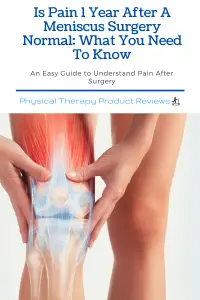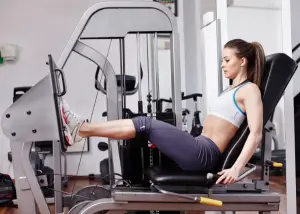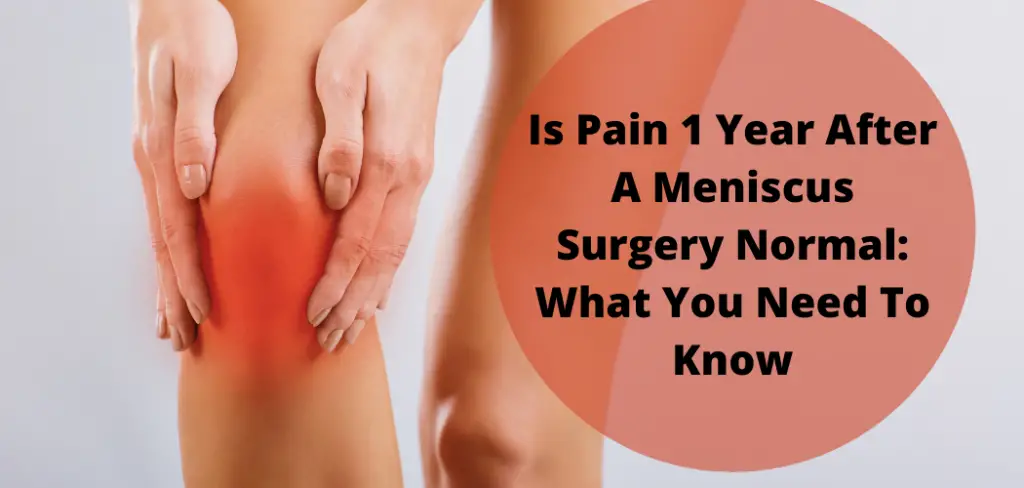It’s been a year since you had your meniscus surgery, and you’re still in pain. Is pain 1 year after a meniscus surgery normal? That’s a common question that many patients ask themselves when they are trying to figure out if something is wrong with their knee after surgery. The internal expectation is that once you have surgery, everything you be fixed and back to normal.
We have all come to know what pain feels like from an injury, but the pain from a one-year-old surgery doesn’t seem right or fair! This can be frustrating, irritating, and deep down worrisome. In this article, we will review how long it takes for the pain to go away post-surgery as well as what may be causing pain 1 year after meniscus surgery.
Is Pain 1-Year After Meniscus Arthroscopy Normal?
We typically do not expect people to experience pain one year after meniscus surgery. This obviously depends on the type of surgery and what all was performed. If you had an ACL reconstruction AND a Meniscus surgery, then pain 1 year after surgery is more common.
 For the majority of patients who have a partial meniscectomy, the pain typically improves by the 2-3 month mark but can last up to 6 months in some patients. If there is pain 1-year after surgery, it may not be from the surgery itself by from other issues that have occurred in the knee since surgery.
For the majority of patients who have a partial meniscectomy, the pain typically improves by the 2-3 month mark but can last up to 6 months in some patients. If there is pain 1-year after surgery, it may not be from the surgery itself by from other issues that have occurred in the knee since surgery.
If you are middle-aged (47-75) then having a meniscus scope surgery may speed up the development of knee arthritis. In this instance pain at the 1-year mark would not be as surprising and would be due to the increased degenerative changes that have been sped up from the surgery.
If you have a meniscus repair, then you are typically non-weight bearing for 6 weeks immediately after surgery while the repair heals. During this time the quad muscles may atrophy and lose significant strength. It takes months to regain the strength lost during those 6 weeks of non-use. If you never get that strength back then pain at the one-year mark would be more understable. Strength doesn’t naturally return on its on. It’s something that has be to worked on and pushed.
How Long Does it Take To Recover From Meniscus Surgery?
Recovery time for a Meniscus knee scope varies depending on the type of surgery performed.
For a meniscus repair, we expect full recovery to be achieved between 3-6 months after the date of surgery. In this surgery, the torn part of the meniscus is repaired with sutures. The patient is non-weight bearing for 4-6 weeks to allow the meniscus to heal. Most people feel much improved by 2-3 months after surgery but some mild swelling, weakness, and occasional pain with activity are not uncommon. This occasional discomfort can last up to 5-6 months in some instances. This surgery takes longer to recover from than a partial meniscectomy.
For a partial meniscectomy, we expect full recovery to happen much sooner, typically between 2-3 months after surgery. In this surgery, the torn part of the meniscus is shaved down to avoid being caught or pulled on during normal knee movements. This also depends on the age of the patient as younger patients heal much faster after this surgery. In addition, the more arthritis and degenerative changes that have already happened in the knee, the slower the healing timeline will be for this surgery. The one drawback to this surgery is that even though you heal faster, there is a risk of developing knee OA in the future.
How Long Does the Pain Last After a Meniscus Surgery?
Pain is common and expected after arthroscopic meniscus surgery. However, we typically don’t expect the pain to last more than 3 months or so. Most people notice the pain goes away around the two-month mark. In some instances, people will continue to have pain up until 6 months post-surgery.
These patients may need more time to build up strength and allow the body to get rid of inflammation in the joint after surgery. This group will have to work longer on their exercises to help get back to normal.
What Causes Knee Pain 1-Year After a Meniscus Surgery?
If pain is still present 1-year after surgery then it could be a missed diagnosis or a lingering deficit such as arthritis from the previous surgery. There are some things that may be causing pain post-meniscus surgery and can include:
Poor Quad and Overall Knee Strength
Pain one year after meniscus surgery may be due to poor quad or knee strength. The quadriceps or thigh muscle accounts for 60% of the function of the knee joint. If the quad muscle (front of the thigh) is weak then this puts more pressure through the knee joint and internal structures such as the meniscus. Pain may not return to normal until you are able to build up enough strength in these muscles. This can take months, even with physical therapy, to build back adequate strength.

Arthritis Development After Knee Surgery
One of the negative effects of having a partial meniscectomy is that it can speed up the development of knee arthritis, especially in middle-aged patients. If the knee develops arthritis after surgery it can cause pain during high-level activities such as squatting, lunges, and going down the stairs. If too much arthritis develops then you may eventually need a total knee replacement in the future.
New Injury to the Knee After Surgery
With any surgery, there is always a risk of injuring your knee during the acute phase of recovery where there is pain, swelling, and weakness. This can cause other injuries such as Patellofemoral Pain Syndrome, Patellar Tendonitis, or Chondromalacia. Because the knee is still recovering it is at a higher risk of injury.
Take mental notes on if the pain is similar in location and the type of pain that you are feeling now. If it feels similar then you likely need to continue to improve your knee strength.
If it feels like it is in a different location or feels like a different type of pain then this may be a new injury that occurred during recovery. Most of these types of injuries such as Patellofemoral Pain Syndrome will improve with strengthening, temporarily wearing a knee brace, and activity modifications.
Tips to Decrease Persistent Knee Pain After a Knee Arthroscopy
There are a few things that you can do to ensure that you have tried everything to get rid of the pain and get back to normal.
Build Up Quad Strength
This is the easiest option but the longest to take effect. It can take months for the muscles of the leg to build up enough strength to stabilize the knee. It can be challenging to increase quad strength without aggravating the knee joint. Some of our favorite strengthening exercises include squats, lunges, and step-ups on a stair.
If these cause pain in the knee then it’s best to back off and try some less intense exercises such as seated knee extensions with resistance, wall sits, and resisted Hip flexion.
Improve Hip Strength
In addition to strengthening the knee, the hips are the next most important muscle group to strengthen. It is important to train the hips because they help stabilize and protect your knee joint. The hip controls the actual rotation of the knee and the alignment.

Some of our favorite hip-strengthening exercises include single-leg deadlifts, reverse lunges, and lateral step-downs. If those exercises aggravate the knee then side-lying hip abduction, Steamboats, and single-leg balance holds are great ways to strengthen the hip with less pain.
Try a Compression Knee Brace
A knee brace can be a great way to reduce pain, protect the meniscus, and just give the knee a little bit more support. It is important to note that there are many different types of braces so you can try many different ones until you find one that works the best for you. Start with the least supportive and work up to most supportive until the pain gets taken away.
We typically start people with a compression knee brace to help with pain and swelling. These can either be open patella knee braces or closed patella. These braces help manage to swell, add a little support without taking over too much, and are easy to use.
Ride a Bike After a Meniscus Tear
Riding a bike can be an amazing way to improve pain and knee function. This is a great way to avoid high-impact exercises but yet still improve range of motion and gain strength. Riding a bike typically doesn’t a torn meniscus and people report feeling better after a good ride. You should try riding for at least 30 minutes every other day until your pain gets better as long as it remains pain-free.
Some of the best exercises to do on a bike are light spinning, sprints, hill climbs, and standing up hard pedals. Just be cautious of riding hard on single-track mountain biking to the point that you have to clip out and plant a foot down to catch yourself.
Strengthening the muscles around your knee is one of the best ways to reduce pain and improve function.
Conclusion
The pain after meniscus surgery is common and expected. If pain persists longer than three months then it’s best to get checked out by a doctor just in case something else might be wrong rather than just pain from the meniscus repair. There are many things that you can do to help reduce pain such as building up quad strength, strengthening your hips, and wearing a knee brace.
How to Stay Active After Cervical Fractures: Expert Tips and Advice
Dealing with Painful Stairs After Ankle Replacement Surgery
Walking After a Total Ankle Replacement: Tips for a Successful Recovery
Exercises While Non-Weight Bearing After Ankle Replacement: Elevation, AROM, Leg Raises, and More
Ankle Pain with Stairs: Causes and Home Treatment Options
5 Common Mistakes You’re Making After an Ankle Sprain
Disclaimer: The information provided in this post is for educational purposes only. This is not a substitute for a medical appointment. Please refer to your physician before starting any exercise program.







